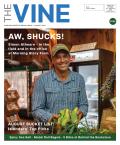In a restaurant, plating is the last step for the kitchen and the first impression for the customer. All the planning, ordering, prepping, cooking and executing culminates in a few final moments when the meat is seared and set, the veggies are ready, the sauce is up and there is nothing left for a chef to do except arrange the food on the plate and summon the server.
Kevin Crowell is the executive chef and owner of Détente and the Sweet Life Café. “Texture, taste and temperature,” he said. “That’s my holy trinity.” Once a dish has some variation of those three elements (smooth/crunchy, sweet/sour, hot/cold,) Crowell moves onto his next step. “I ask myself, ‘What am I trying to convey?’”
The answer is not always as simple as it seems. You wouldn’t be wrong to think that a pork Bolognese is meant to showcase delicious, slow-cooked, juicy pork. But Crowell wanted only to talk about the gremolata (a condiment made of chopped herbs and lemon) that garnishes that dish. “It’s not the main player, but it’s really effective,” he said. “The hidden pops of flavor take your palate away, then bring it back.”
After five seasons at the Sweet Life Café Chris Gianfreda is now the chef at the Outermost Inn. “I like my plates to look clean, but also a little funky,” he said. For the past three years he has spent the off-season cooking in New Orleans and the influence is unmistakable. Oysters are chargrilled and garnished southern-style. Smoked duck is served alongside peach pepper jelly and pimento cheese grits wrapped in zucchini. But he stops short of calling his food homey. “I’m into modern techniques too,” he said. “Gels and froths and re-molding stuff into things they are not.”
“You can conceptualize anything,” said Ben deForest of Red Cat Kitchen. “But you also have to be able to put it on the plate.” On the art of plating he says, “It’s the fruition of all the work it takes to get there. It’s the end game.”
deForest is in his fifth season at the Red Cat but he is always tweaking his menu—as of last week it was in it’s 78th iteration this summer—and his food is still evolving. In fact, he himself is still evolving. deForest is newly engaged to Erica McCarron, Red Cat’s pastry chef, and he recently celebrated a year of sobriety. He is thrilled, exultant even, about the ways his new lifestyle affects his work. “Clarity is my new buzz,” he said. “I feel like there are lightning bolts coming out of my fingers when I’m working.”
When putting together a new dish, deForest approaches it like a puzzle. “You just have to wait and see how it fits and when the food just moves fluidly from my hands to the plate I know I’m doing it right.”
Pastry chef McCarron’s creations include Reese’s cheesecake with Oreo crust, frozen key lime pies and sticky gingerbread cake. Many of her dishes come from a dream or a craving, and rather than scrutinizing the inspiration she trusts her instincts and gets to work. A brainstorming session might result in maple-bacon-cinnamon rolls and though she doesn’t work in the kitchen during dinner service, McCarron’s vision follows her desserts to the table.
As the chef of two restaurants with very different concepts, Scott Cummings takes his basic plating style and adapts it for the situation. “I always, always work in odd numbers,” he said. The rule of odds is common among chefs who believe that, for example, three or five scallops is more visually appealing than four.
At 20 by Nine, the plates are smaller and have to be prepared quickly. At Down Island, where diners expect a more leisurely meal, the plates are more involved. In both cases, Cummings prefers a simplistic, natural approach to the food he’s working with. He never wants a dish to appear overly contrived or busy, “The less manipulation the better. Otherwise the flavors get lost,” he said.
Cummings also strives for an element of surprise in every dish. “I want my customers to be comfortable with how their food looks visually, but surprised by the taste.”











Comments